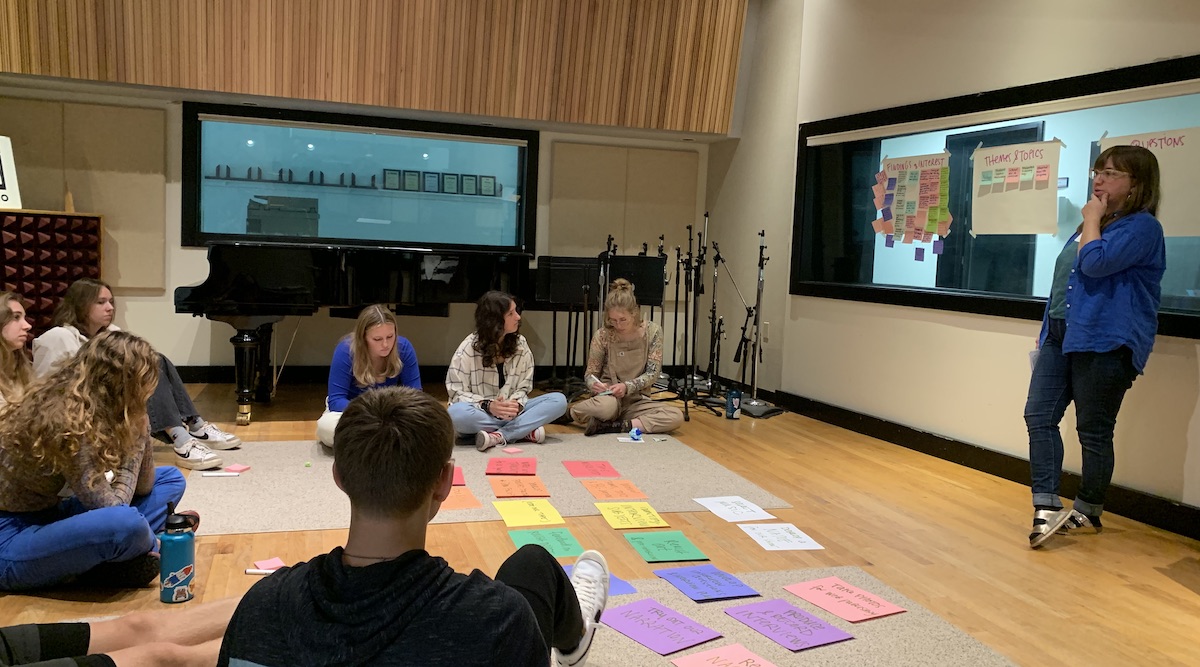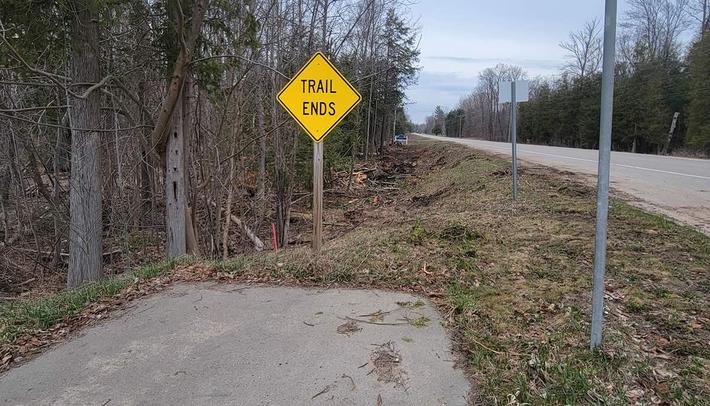
Seeking Help: Students and Mentors Reflect on Local Teen Mental Health Survey
“One thing we took away is that kids really don’t know how to help themselves.”
By Anna Faller | Nov. 4, 2023
It’s no surprise that mental health in American teens has seen a recent decline. In fact, according to national data, about 15 percent of middle and high school students experienced a major depressive episode in the last year, and more than a third (about 37 percent) reported persistent feelings of sadness.
Similar trends are on the rise in northern Michigan, says Dave Mengebier, president and CEO of the Grand Traverse Regional Community Foundation (GTRCF), which serves Antrim, Leelanau, Grand Traverse, Kalkaska, and Benzie counties with a mission to improve the quality of life in those communities.
“The foundation has been very involved with youth issues throughout its 31-year history,” Mengebier says. “We were aware from all the work that we do in this space that we had really reached crisis proportions.”
To solve a crisis, you call in the experts—but while peer-reviewed research and best practices provide valuable data to consider, who better to offer insight into teen mental health struggles than teens themselves?
“We wanted high school students to really take on that leadership role and ask their peers what’s causing their anxieties, stress, and depression, and where they turn to alleviate those things,” Mengebier explains.
Authentic Voices
Enter: The Youth Wellness Initiative (YWI). Hosted by GTRCF and financed through the Michigan Health Endowment Fund, the program aims to uncover the primary causes of poor mental health in local adolescents and then use those findings to help inform available resources and community planning.
The project has been split into two phases, the first of which is a student-led survey completed earlier this year. The second phase, which is still in the works, will involve collaboration between student researchers and Juliet Hinely, an independent producer for Interlochen Public Radio, on a series of podcast episodes in relation to the survey’s findings.
The initiative kicked off in February when 14 high schoolers from all five counties signed on as researchers to help design and facilitate an anonymous survey that would gather information from their peers about their experiences with mental health challenges.
Guided by project coordinator Dr. Ashley Drake and veteran research strategy consultant Woody Smith (of marketing research firm Avenue ISR), the group began by establishing parameters—including foundations for research and a syllabus—before brainstorming topics the students were most interested in investigating. “We asked what we really wanted to focus on in this particular region that [either] reflects national data or is more specific to the lived experience of the youth here,” Drake says.
From there, the students coalesced around a set group of topics before several rounds of revision and feedback produced the survey’s final draft. Then came a period of local outreach wherein the survey was made available to local schools and distributed among the campuses’ social communities (think: extracurricular clubs, sports teams, and the like).
The survey ran for about three weeks, in which time the group collected 530 responses across 20 high schools. Those responses were in turn used to formulate 11 recommendations to advocate for community youth mental health services.
Survey Says
By May, the final numbers were in—and the results were more than a little surprising.
For starters, there’s the sheer number of local youths experiencing mental health struggles. According to the YWI’s final report, 24 percent of area high schoolers experience moderate-to-severe depression, while about 40 percent report comparable anxiety levels.
“I was surprised to see [those percentages] of students feeling anxious, sad, or depressed,” says Drake. “It really just brought to light that many students are silently suffering.”
The study revealed that schoolwork and grades are primary stressors for teens, especially when compared with more obvious triggers like news and social media. Ellen Grams, a Traverse City Central High School student researcher, says that the intense discomfort many students associated with school was an unexpected finding.
“I think the survey was really helpful because we got to hear directly from kids,” says Grams. “What they’re experiencing is really specific, and it’s important to bring light to this issue from [their] perspective.”
A third takeaway is the tenuous relationship between many students and community mental health resources. Based on the YWI’s study, only about 19 percent of respondents said they felt comfortable approaching school officials, like teachers or counselors, about their mental health, and another 17 percent felt they had no one to talk to at all.
Further, of those who indicated that they’d be prepared to ask for help, nearly a third didn’t know where to start.
“That was definitely surprising,” says Grams. “I [anticipated] that there was a lack of resources, but I think one thing we took away is that kids really don’t know how to help themselves.”
Other notable findings support time outside or in natural spaces and the implementation of “chill-out” zones at school as powerful de-stressing tools for teens. Last but not least, a key component of the YWI’s conclusions calls for the community to help squelch unnecessary stigma and increase access to critical resources.
The Big Takeaways
Here are the key research findings from the 2023 Youth Wellness Initiative survey.
1. High school students in northwest lower Michigan are experiencing significant mental wellness challenges today, including anxiety and depression.
2. Many students, especially those experiencing anxiety and depression, do not have anyone they would feel comfortable talking to if they were feeling sad, anxious, or hopeless.
3. Because mental health issues and ways of addressing them are not “normalized,” many students do not know how to address their mental health and are reluctant to seek help when they need it.
4. Students would feel more comfortable talking to friends and family, rather than teachers and coaches, if they were feeling sad, anxious or hopeless.
5. Time spent outside in nature helps the vast majority of students to de-stress.
6. Students in large numbers would use chill out rooms/spaces, opportunities to learn techniques to center and de-stress, more opportunities to talk to counselors or therapists, a school buddy system, and other approaches if they were feeling stressed out, anxious, or down.
Next Steps
So, how will this information be utilized? First and foremost, participating schools and teen-focused organizations plan to increase awareness about mental health resources already in place. From there, the next step is to improve and expand access to those resources.
Northwest Education Services (aka North Ed), for example, has spent the last several years testing and refining mental health curricula with a focus on socio-emotional competencies—e.g., self-awareness, self-management, social awareness, relationship skills, and responsible decision-making—in all three grade levels throughout its districts.
“We want to make sure we’re attuned to our students, and the [YWI] results support the continuation of those programs, as well as new initiatives that might be helpful,” Superintendent Nick Ceglarek says.
Ceglarek also underscores a significant and ongoing expansion of school social work positions in North Ed’s districts, as well as staff-development opportunities (many of which surround student health and socio-emotional wellbeing), and recently-implemented peer-to-peer programs, which offer safe spaces for students during the day and encourage conversations around mental health.
Meanwhile, LIFT Teen Center—which partners with secondary school systems in Northport, Suttons Bay, and Glen Lake—hosts free suicide-prevention trainings (through a program called ASIST), as well as mentorship-based after school activities, field trips, and relationship-building that promote health and wellness.
LIFT also has plans to implement resource guides—“to provide options for managing stress and [contacts] for students who need to talk with someone,” Executive Director Rebekah TenBrink explains—while taking steps to promote the importance of mental health with its younger program participants.
“If anything, I think we all know how important it is to have someone in your corner and advocating for you,” she adds.
As for whether the student researchers feel their voices are being heard? Drake is cautiously optimistic. “They’re always kind of shocked and delighted when people ask them questions and pay attention to what they have to say. There’s already been a lot that the community has done to think through this, and I think it’s really valuable that it’s being taken seriously,” she says.
The real work though, is just beginning.
“The onus is on all of us,” TenBrink adds. “We believe in our teens, we believe in our youth, and we will advocate relentlessly to provide them with the world that they should be growing and maturing in.”
Learn more and see the full report at gtrcf.org/priorities/youth-wellness-initiative.html.
Trending

Walking in an Artsy Wonderland
Michigan Legacy Art Park is hosting the “Raindrops” artwork created by Dewey Blocksma and Patricia Innis at th... Read More >>
Seven Takeaways from Local Real Estate Agents for the Spring/Summer Market
The last few years in local real estate have been akin to what one local agent described as the “wild west,” w... Read More >>
Blazing the Boyne City to Charlevoix Trail
We’re getting ever closer to an interconnected northern Michigan thanks to ongoing work on the Boyne City to Charlev... Read More >>


